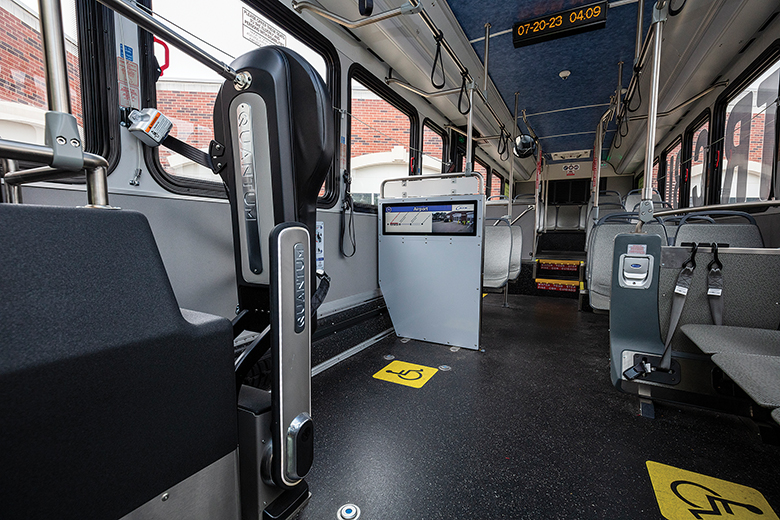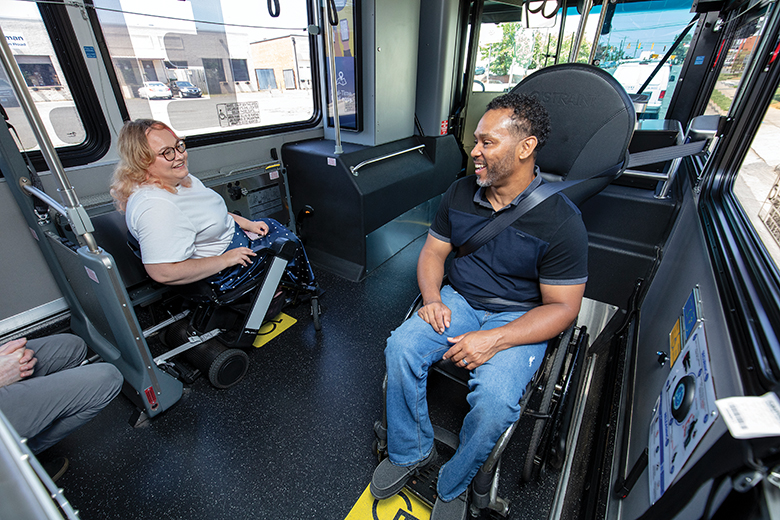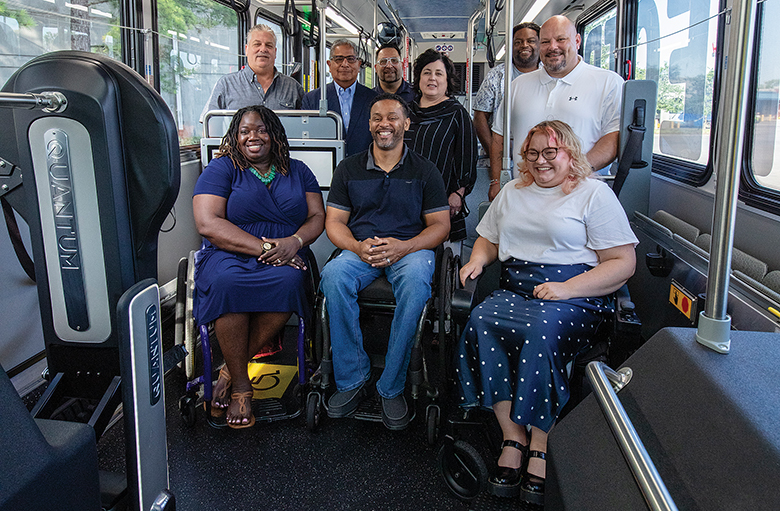
Serving a ridership of nearly 10 million riders annually in the Charlotte Metropolitan Area, Mecklenburg County and surrounding areas, the Charlotte Area Transit System (CATS) strives daily to meet the varying needs and ADA requirements of its riders. Q’STRAINT, with a mission to offer innovative solutions, seeks to ensure equal safety levels for all riders. CATS is committed to four core principles: sustainability, equity, safety, and accessibility. Both entities share a dedication to safety, accessibility, and equality, making them ideal partners for a recent pilot program. To enhance accessibility for all, CATS recently launched a pilot initiative in collaboration with Q’STRAINT, the developer, and manufacturer of the QUANTUM self-securement system and the QPOD. The QUANTUM is a groundbreaking advancement as the industry’s first fully automated rear-facing wheelchair securement system.
For riders to secure themselves safely with QUANTUM, the process is simple. The bus driver releases the vehicle’s ramp for the rider. The rider embarks on the bus and centers their wheelchair on the backboard of the QUANTUM system. When the rider presses the “Secure” button, the system takes approximately 25 seconds to safely secure the wheelchair. The driver presses an additional button for the final squeeze, and the trip is back underway.
“While the Q’POD self-tensioning system lessens CATS’s risk of wheelchair tipping and reduces operator injuries,” said Mitch Drouillard, southern regional sales manager for Q’STRAINT, “QUANTUM is the pinnacle of modern safety technology. It is an an ADA independence evolution with telematics, allowing agencies to make operational decisions based on data.”
In conjunction with the Q’POD tensioning system by Q’STRAINT, CATS developed a novel new way for its ADA passengers to ride in comfort: the C3-SPACE.
Developing the C3-SPACE
CATS refers to the section of the bus that houses the QUANTUM for ADA riders as the C3-SPACE and embarked on a pilot program to test proof of concept. In addition to the securement tensioning system, the space also provides a privacy barrier and a dedicated wayfinding screen for rear-facing riders in the QUANTUM system. CATS obtained the QUANTUM and support components through Gillig parts contracts, in addition to developing a one-of-a-kind privacy barrier in partnership with a leading manufacturer.
The C3-SPACE aligns with the City of Charlotte’s strategic ADA Transition Plan to address any barriers to achieve better accessibility. The ADA Transition Plan’s goal for success is that accessibility is no longer a separate item to be considered – rather, it becomes part of the transit culture and is seamlessly incorporated into the workflow.
All new bus purchases will include the C3-SPACE and will be funded through a combination of local funds, formula, and competitive grants, making the C3-SPACE affordable for any size transit property.

The solution is unique to Charlotte and CATS, perhaps even to public transit. Incorporating existing OEM technologies with original cutting-edge designs has changed how the ADA community travels. Passengers no longer require assistance – they now have the ability for self-determining travel.
“The incorporation of multiple technologies brings a 100-percent fully-dedicated mobility space that is the conduit for an independent and autonomous transportation experience for Charlotte’s ADA community,” said Jennifer Fehribach, general manager of the Bus Operations Division of CATS. “It provides 100 percent independence, equal to that of ambulatory passengers.”
Implementation and Testing
The C3-SPACE (incorporating QUANTUM) prototype required several iterations of the incorporated space and includes newly developed components. The implementation process spanned several months due to prototype component fabrication and sourcing of atypical components. New buses will have the C3-SPACE installed by the bus manufacturer during production. The project team and Vendor Partners collaborated as a think tank in such a manner that setbacks were nominal, and solutions were identified quickly.
CATS dedicated significant planning efforts to ensure operators were trained and informed of the multiple technologies in the C3-SPACE to provide full autonomy to Charlotte’s ADA community. The Q’STRAINT team provided a comprehensive all-day “train the trainer” session on the new QUANTUM, in addition to the Q’STRAINT SLIDE ‘N CLICK securement device that is a secondary forward-facing solution within the C3-SPACE.
To avoid overburdening training resources, operators are being trained on a priority basis, with the buses dedicated to servicing the CATS routes with the highest mobility device usage.
To date, CATS has provided 1:1 hands-on training to 80 percent of its operators. Bus Ambassadors, employees dedicated to riding fixed-route buses and serving as customer service resources, were also trained on the dedicated C3-SPACE routes for the first two weeks of revenue service.
“Q’STRAINT has proved its commitment to continually improving its product line and patronage in the community through this groundbreaking innovation,” Fehribach said. “Q’STRAINT and their dedicated representatives have always provided platinum customer service and are quick to partner with transit properties on new initiatives.”

Community Feedback
CATS tested the C3-SPACE’s compatibility with ADA passengers by allowing them to ride the system and provide feedback and input about their encounter with the space.
Melanie Dunston, a Charlotte Court Advocate, was one such rider. Residing in Charlotte, Dunston is a mother of two and a grandmother of two. She is on the Board of Disability Rights and Resources and advocates for disabled residents of the Charlotte Metropolitan Area.
“I thought the QUANTUM was so comfortable,” she said. “It was easy to get into it, and I really felt very secure. I usually don’t get on buses because I was always being pushed back and forth. For the first time it’s free-flowing and secure, and I can talk to people on the bus.

“Additionally, sitting in the QUANTUM and looking at the screen is much better,” she added. “I have choices to get on and off now, where before I couldn’t even reach the bell. Someone had to reach for me. So now I’m much more independent.”
With this year being the 33rd anniversary of the ADA’s signing, the significance of this advancement for transit was not lost, suggested Dunston.
“Just doing the ride on the QUANTUM was everything for me,” she said. “It was freedom. I felt secure, and I really hope that we can get more people that need peer-to-peer support to travel onboard. This will be a great thing.”
Chablis Dandridge was another rider who tested the C3-SPACE. Dandridge had not been on a bus since 1995, the year of his injury.
“The independence was the best thing in the world,” he said. “To be able to roll up the ramp, to put myself in the QUANTUM, and to press a button and then get locked in. It was unmatched.”
“In 1995, it was very wiggly and loose,” he continued. “Today, even in the Q’POD, it was very tight, snug, and secure.”
Dandridge said the lap belt felt very comfortable, and that he felt very secure as a person with limited mobility and maneuverability.
“It felt great to be able to get on the bus and be completely independent,” he said. “It’s almost like a small sanctuary.”
Jordan Haye, another ADA rider, also had a great experience with the QUANTUM and C3-SPACE. Her equipment requirements presented an interesting test case for the system.
“My chair is a bit unusual,” she said. “It’s a folding power chair, and it’s only about 60 pounds, which is pretty light compared to other power chairs. I’ve also heard it’s a bit narrower. So, when I first saw this design, I was afraid the QUANTUM wasn’t going to secure my unique chair. “But, to my surprise, I felt really secure, and it just adjusted to my chair.”

A Path Forward for Charlotte’s ADA Riders
CATS is expected to have the C3-SPACE on 61 buses in full revenue service by 2024.
Incorporating the results of the pilot program and customer feedback will result in a new way to travel for CATS’s ADA passengers. And, ideally, it is a solution that can help agencies across the United States to improve accessibility and rider autonomy at their own operations.
“Q’STRAINT is a company that embraces transparency, including customer feedback,” Fehribach said. “I have great reverence for an OEM that embraces challenges. For QUANTUM, that included customer concerns about its rear-facing nature, about passengers staring at them, and knowing their own stop location. The C3-SPACE mitigates both concerns by providing more privacy and the visual experience of a forward-facing passenger.”
